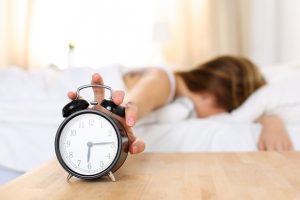Welcome to San Diego Blog | March 12, 2021
Spring Forward, Fall Back on Sleep? All You Need to Know About Daylight Saving and Surviving the Time Change

Many look forward to daylight saving time (DST) as a sign that longer, warmer days are near. But that lost hour of sleep as the clocks turn forward can make you feel out of whack.
The lethargic, out-of-sorts feelings that often follow the time change aren’t just in your head. A recent study found that the annual transition to and from DST has long-term effects on health and can be associated with an increased risk of heart attack and stroke.
We have everything you need to know on why this happens and how to avoid feeling so sluggish – and minimize your health risks.
How Daylight Saving Time Disrupts Your Circadian Rhythm
“While only one hour of lost sleep may seem insignificant, it can really throw off your circadian rhythm,” explains Keara Ahern, APN-C at Penn Family Medicine Voorhees.
Otherwise known as the sleep/wake cycle, your circadian rhythm is the 24-hour internal clock that regularly cycles between periods of alertness and tiredness. Although the sleep/wake cycle is internally generated, it can be affected by external factors like behavior, environment, and medication. The most impactful environmental factor is light.
“When it’s dark, the eyes send a signal to the hypothalamus (the part of the brain that controls circadian rhythm) that it’s time to feel tired. The brain then tells the body to release melatonin, a hormone that induces sleepiness,” explains Ahern.
In contrast, exposure to light suppresses the secretion of melatonin. This is why the sleep cycle coincides with day and night. When turning the clocks forward causes less light in the morning and more light at night, it can make waking up and falling asleep at your regular times more difficult.
How to Adjust to Daylight Saving Time
While there is no way to recover from lost sleep, there are some ways to help ease the transition. These five tips will help your body adjust to the time change:
Get plenty of sleep before turning your clocks ahead
“If you aren’t already sleeping the recommended seven to nine hours per night, make sure you do so in the week leading up to the time change,” says Ahern.
If you’re already sleep-deprived, the transition will be even more difficult.
Get appropriate light exposure
Use light to help send signals to your body. Get outside in the morning to soak in some sunlight, since this will help you feel more awake. Before bedtime, be sure to dim your lights or at least limit your exposure to bright light to help your body grow tired and ease into sleep.
Reevaluate your evening activities
Try to avoid things that will make falling asleep difficult or inhibit getting a restful night’s sleep. These include drinking caffeine or alcohol a few hours before bed or squeezing in a late-night workout.
Go to bed 15-20 minutes earlier leading up to DST
In the week before DST, try going to bed 15-20 minutes earlier each night. If this isn’t possible, make an effort to turn it in earlier on the night the clocks change. This will allow you to regain a bit of the hour lost and will help minimize those lethargic feelings the next day.
Let yourself sleep in on Sunday
The clock springs forward at 2 am the second Sunday in March each year. Let yourself sleep in an extra 30 minutes on Sunday morning and expose yourself to sunlight when you first wake up. This will increase alertness and help your body clock adjust. Adjusting to the change will get easier as the days get longer and natural light exposure increases.